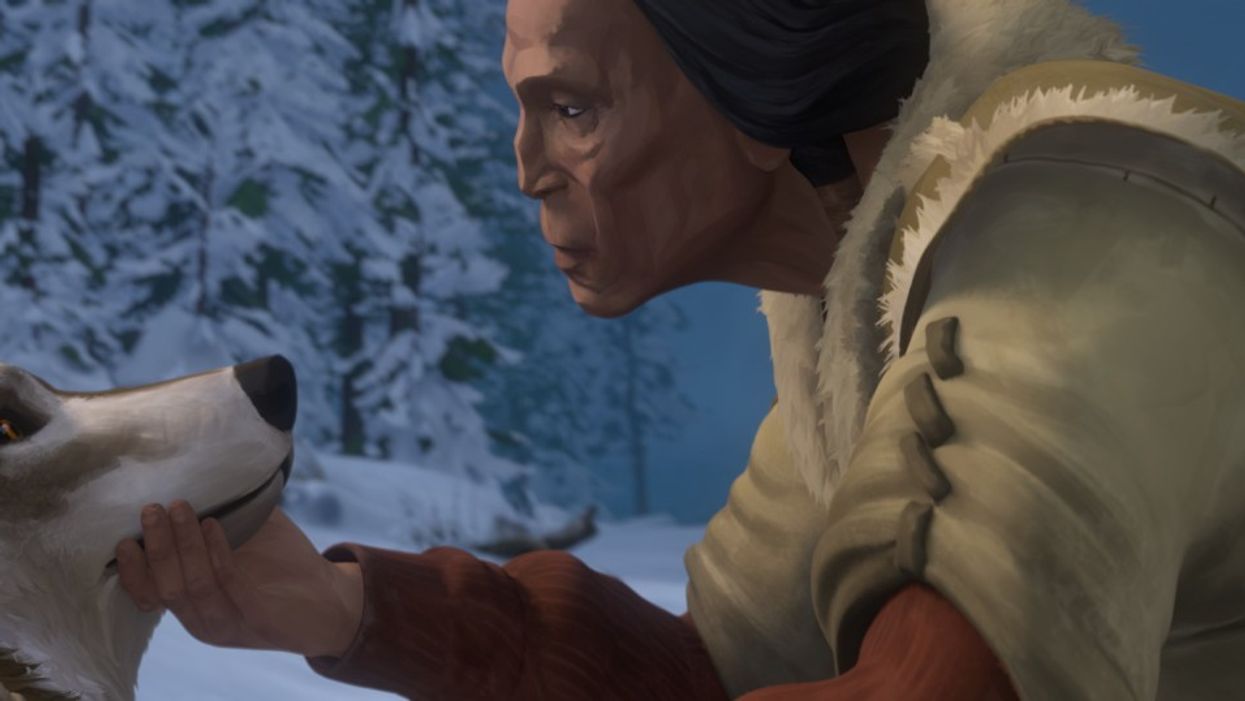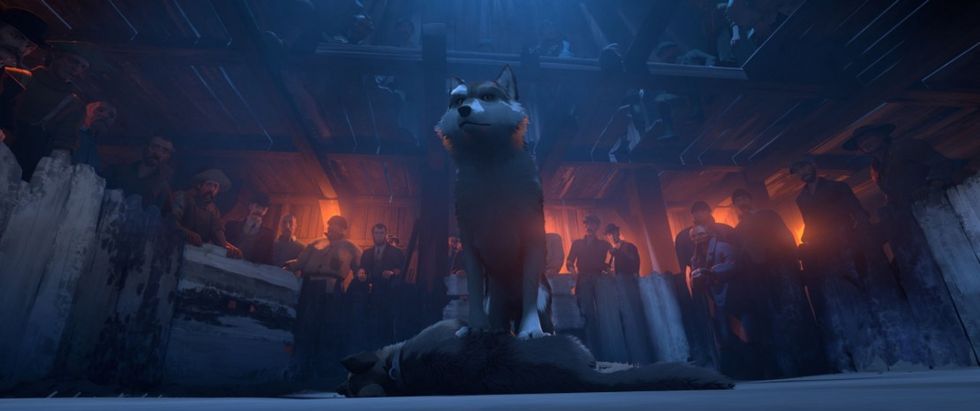Humanity Through Animation: Director Alexandre Espigares on Netflix's 'White Fang'
When developing 'White Fang', maintaining the tone of Jack London's original book was of utmost importance to Alexandre Espigares.

If you've ever felt alone, scared, angry, on the defensive, excited, hungry, or in love, then you'll certainly empathize with the protagonist of the new Netflix film, White Fang, a truly human story about the life—from puppyhood to adulthood—of a wolf-dog.
As we watch White Fang move through the world, we empathize with his struggles as we would with a human, a human, that is, with experience in dogfighting. Featuring voiceovers from Rashida Jones, Nick Offerman, Paul Giamatti and others, the film has a full Alaskan sled-load of excitement, complete with powerful, compassionate writing set against a beautifully visualized backdrop.
No Film School spoke with director Alexandre Espigares about the challenges of making his animated film, now available on Netflix.
No Film School: Can you tell me a little bit about how you achieved the half-drawn, half-photorealistic quality of the film?
Alexandre Espigares: It’s funny that people ask so much about the technical aspect, because they don’t think with computer animation that it would be possible. Many studios, American studios in particular, stick to one kind of film because they have experience and know that it works. So basically, you can put any look on any character, and we decided to go with a more painterly look. Mainstream studios tend to not be as experimental as our approach was.
There are textures that look like oil paintings, but they are obviously done on the computer. You can basically stick any texture on a character, but we decided to go with the painterly look, the other reason being that you might need a lot of r-and-d to get to that photorealistic look, to get a certain texture of skin, for instance. We didn’t have that time.
The look we chose goes with the tone of the film. Everything in the film has a fairly gritty tone for a family entertainment film, and I think the characters' faces, if you look at them, are a little bit crooked and don’t look symmetrical. A more rough look with the brushstroke works fine with this story. A look that was too soft or too rounded would not have worked well with a story that has this level of grittiness.
NFS: What sort of timeframe was there for the film?
Espigares: The script had been around for 12 to 15 years before I came on the project. There were many reasons for that but I don’t know all of them. I myself was on the film for three-and-a-halfyears, roughly. There were some preliminary drawings that had been done that were much like the Disney style from the late 1980s. It had a different tone, with a narrator in some parts, and I really wanted to go against that. We wanted to do something that was more contemporary.
The production was in two countries. There were three countries that had producers, Luxembourg, France, and the US, but the film was made in Luxembourg and France.
"A look that was too soft or too rounded would not have worked well with a story that has this level of grittiness."
NFS: What kind of research did you do regarding animal motion?
Espigares: People always tell me that the animals look better than the humans, and I totally agree with that [laughs]. We tried to justify that by saying that the human world is seen through the animals’ eyes—if their movements are not spot-on, that’s because the animals perceive them that way. For the wolves, you can get pretty much everything from the Internet in terms of animal motion, but we also went to an animal park that was not too far from the studio in France. They have wolves of all kinds, including black wolves, gray wolves, and white wolves. They have them in semi-captivity, so they can roam freely.
We spent two days there with a specialist in wolves who gave us all the insights we needed, i.e. how does a wolf move? What are the signs of submission? What is the hierarchy in a wolf pack? There was one thing I used in the film that was very interesting, which is when wolves hold their ears off to the side (this is not something dogs do). It was really important for us to know these things and apply them to the film. Then again, it’s a movie and you can get away with taking certain liberties. I think the expressions the animals have are a bit more anthropomorphic than you would normally get from a dog, perhaps.

NFS: There's a lot of disparity between the way the animals appear and the way the humans appear. Could you explain what motivated that?
Espigares: From the beginning, we wanted everything to be through the eyes of White Fang: How does the world of animals work versus the humans, and so on. On the more technical side, you could say the animals were done in one kind of animation and the humans in motion-captured animation (not all of them but a large part). Because the humans are motion-captured, you would expect their movements to be more natural, but the results were sometimes unexpected.
Paradoxically, you get more natural results with the animals than you do with the humans, although the humans were captured from real human figures. It’s one of the quirks of motion-capture, that it may give you a level of detail you never asked for. This makes the humans seem awkward at times, but you could justify that by saying this is the way the wolves view humans. They don’t read humans like we do. We know humans’ expressions, and animals obviously don’t know them. We also had to keep the camera very low, to show the animals’ perspective.
"It’s one of the quirks of motion-capture, that it may give you a level of detail you never asked for."
NFS: White Fang is a very old story; I actually read the book as a kid. What was the most important element you wanted to capture in adapting this book?
Espigares: A lot of people read this book as kids. I didn’t—a lot of school kids in France read it, but because I didn’t go to school in France, I didn’t. Once I had read the script, I felt I needed to read the book, and so I read it. After I read the book, I put it aside, because I realized there was no adaptation we could make of the book that would be 100% true to it. If we were, it would be a 5-hour film, and we had 85 minutes to work with.
Espigares: I put the book aside and worked from the memories I had of the book, knowing that I had to cut characters and, well, cut a lot of things. I decided to put certain scenes into the script that were not originally in the book and to leave out scenes that were in the book, the main idea being to stay true to the book's tone and toward its main character. We had to narrow the book down, boil it down to its bare essentials. It was always all about the tone.
Also, we had to stay family friendly—we had to show the violence without showing the violence. We got very creative, and I like the way we did it. Some of my favorite scenes, like the dogfight montage, is pretty intense, more so because we don’t see what’s happening; the violent acts are always hidden behind people. But you get the tone of it—the music, the people shouting, the colors changing—and we tried to keep that level of intensity without showing the violence.
NFS: How do you feel this film speaks to the current state of animal rights and welfare?
Espigares: I get that question a lot, and interestingly enough, it’s something I hadn’t thought about. We really were just focused on making a good film. Although on a more conscious level, I’m an animal lover and I hate to see an animal harmed in any way. I love dogs. I don’t own a dog, but I love them.
I think some of the love I have for animals shows on film. When an animal is your protagonist, you can’t do it any other way. On the other hand, in the book, Smith is so cruel and violent, he’s almost like a caricature. In the film, I never tried to push any message on the viewer.
For more information on 'White Fang,' click here.












